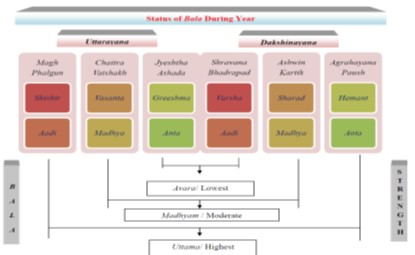Immune enhancing measures in Children
DOI:
https://doi.org/10.21760/jaims.9.4.24Keywords:
Immunity, Lehana, Suvarnaprashna, Dinacharya, Medhya Rasayana.Abstract
Children are the epitome of innocence and purity therefore the child’s health care should include specific biological and psychological needs that must be ensured to the survival and healthy development of the child, the future adult. They are in constant danger of developing infections due to underdeveloped immune system. Ayurveda emphasizes not only treating diseases but also by maintenance of health by improving immunity of the body. Several measures are considered to enhance the immunity in children. To ameliorate the immunity Acharya Kashyapa described a special formulation by the name Lehana in which herbal drugs are mixed with Madhu (honey) and Sarpi (clarified butter) to the child for the first time. Suvarnaprashna is another method adopted for physical and mental development in newborn and preschool children. Phalaprashan Samskara is a ritual or sacrament acknowledged by him where the first solid food is introduced to the baby that helps in strengthening the bodily tissues. In our classics as a part of Dinacharya, Abhyanga and Snana helps to keep child’s immune system performing at its peak by stimulating the lymphatic system. Nidra (adequate sleep) contributes to child’s overall wellbeing and establishing healthy sleep habits with recommended amount of sleep for their age is an absolute necessity to rejuvenate the body. Daily practice of Yogasana and Pranayam in children helps them to boost their immune system by synchronizing their mind and body. Encouraging children to follow an Ayurvedic routine helps in balancing and enhancing their innate capacity to grow, heal and thrive.
Downloads
References
Premvati tewari, Ayurvediya prasutitantra evam striroga, Chaukambha orientalia, Varanasi, 2003. Part 2, Chapter 5, p – 226.
Kashinath Shastri, Gorakha Nath Chaturvedi.Charak Samhita (Vidyotani Hindi commentary), Varanasi: Chaukhambha Bharti Academy, Part – I (Reprint year: 2013) and Part-II (Reprint year2013), Sutrasthana 28/6, p - 570.
Kashinath Shastri, Gorakha Nath Chaturvedi.Charak Samhita (Vidyotani Hindi Commentary), Varanasi: Chaukhambha Bharti Academy, Part – I (Reprint year: 2013) and Part-II (Reprint year2013), Sutrasthana 28/6, p - 570.
Pandit Hemraja Sharma, Satyapal Bhisagacharya. Vrddha Jivaka, Kasyapa Samhita, Chaukhamba Sanskrit Sansthan; Varanasi, Reprint 2015, Khilasthana 4, p - 378.
Pandit Hemraja Sharma, Satyapal Bhisagacharya. Vrddha Jivaka, Kasyapa Samhita, Chaukhamba Sanskrit Sansthan; Varanasi, Reprint 2015, Sutrasthana Lehanadhyaya, p - 6-8.
Kaviraja Atrideva Gupta. Ashtangahrdayam (Vidyotini Hindi Commentary), Varanasi Chaukhambha Prakashan (Reprint, 2016), Sutrasthana 2/1, p – 21
Kashinath Shastri, Gorakha Nath Chaturvedi.Charak Samhita (Vidyotani Hindi commentary), Varanasi: Chaukhambha Bharti Academy, Part – I (Reprint year: 2013) and Part-II (Reprint year2013), Sutrasthana 6/8, p – 135.
Kaviraja Ambikadutt Shastri. Sushruta Samhita (Ayurveda Tattva Sandipika Hindi commentary), Part – I. Varanasi Chaukhambha Sanskrit Sansthan;(Reprint 2013), Sutrasthana 21/18, p – 117.
https://blog.mygov.in/yoga- for- children- with- special- needs/
Kaviraj Ambikadutt Shastri. Sushruta Samhita (Ayurveda Tattva Sandipika Hindi commentary), Part – I. Varanasi Chaukhambha Sanskrit Sansthan;(Reprint 2013), Shareersthana 10/72-74,p - 84.















